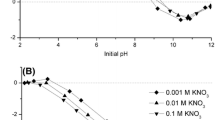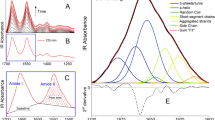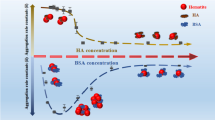Abstract
In the present work, surface interaction of L-alanine (L-ala) has been investigated on hematite (α-Fe2O3), an abundant mineral on Mars, as a function of time (5 min–48 h), pH (4.0 and 6.20 ± 0.10) and concentration (1 × 10−3 M–10 × 10−3 M) with optical absorbance and energy-dispersive spectroscopy (EDS). Adsorption parameters (XM and KL) were calculated from Langmuir adsorption isotherms. L-alanine has maximum affinity (65.31 %) in its zwitterionic form at pH 6.20, while it is only 29.86 % adsorbed at pH 4.0. Possible astrobiological implications are discussed.
Similar content being viewed by others
Avoid common mistakes on your manuscript.
Introduction
It is believed that minerals might have played a key role not only for catalysis but also for the stabilization of newly formed biomolecules through adsorption-desorption processes in early periods of chemical evolution (Bernal 1951; Brack 2006; Cleaves et al. 2010; Ali et al. 2004). Recently Shankar et al. 2012 have shown the influence of iron oxides on the oligomerization of amino acids under wetting/drying condition potentially common on the primitive Earth. Iron oxides were found to be good adsorbents for complex chemicals such as single-stranded DNA and betamethasone disodium phosphate (BMP), a glucocorticoid drug (Cleaves et al. 2011; Vera et al. 1997).Arora et al. 2007 discussed the implications of the hematite-water system for prebiotic chemistry under Martian conditions. Biomolecules may be stabilized on solid surfaces allowing their further polymerization into proteins and nucleic acids, which may be key components for the formation of protocells.
Therefore, to further explore the importance of minerals as surfactants, the interaction of L-alanine (L-ala) on the abundant Martian mineral hematite (α-Fe2O3), has been studied and the results are reported in this communication. Interactions of L-ala (pKa2.3) on hematite surfaces were studied at two different pH values (4.0 and 6.2). At pH 6.2 L-ala is in zwitterionic form while at pH 4.0 it has both the zwitterionic as well as cationic form (Scheme 1). So the specificity for attachment and contribution of different chemical forms of adsorbate in adsorption could be analyzed. The stability of adsorbate under study at varying pHs is the major concern for Astrobiological investigation as these minerals are also known for their catalytic role in polymerization and decomposition of biomolecules (Zaia 2012; Marshall-Bowman et al. 2010; Gururani et al. 2012a; Ferris et al. 1996).
Experimental
All reagents were of analytical grade. Hematite (red ferric oxide), L-ala and H2O2 were purchased from Fisher Scientific, Sigma Aldrich, India, and Qualizen respectively. Triple distilled-deionized water (pH 6.8 ± 0.1) was used throughout the study. All containers, measuring equipment and assemblies were of borosilicate glass. A JascoV-550, UV/VIS/NIR spectrophotometer was used for determination of absorbance of the amino acid. The pH was recorded on Hanna pH meter (model pHep, Accuracy: ±0.1).
The sequential steps involved in the preparation and purification of adsorbent are shown in Scheme 2. The purity of mineral was determined by scanning electron microscopy (SEM) and energy-dispersive spectroscopy (EDS) on S-3700N, Hitachi Instrument using an acceleration voltage 15.0 kV and take off angle 44.1° (Figs. 1 and 2).
The adsorption of L-ala on hematite in aqueous medium was studied as function of pH, time and concentration of adsorbate. Adsorption of L-ala in varying concentration (1 × 10−3 M–10 × 10−3 M) over different pHs was studied in order to obtain saturation point by adding relevant buffer (sodium acetate-acetic acid or borax-boric acid) to the amino acid solution (5 ml) containing hematite, keeping in mind that the buffer solution should be a very poor ligand so that stable complex formation with the mineral could be avoided and this was confirmed by using different buffer concentration on L-ala solution. The concentration of L-ala was determined using UV/VIS spectrophotometer at 201 ±2 nm (Fig. 3).
Buffer solutions of L-ala (5 ml) at different pH values was added to hematite (50 mg) in separate conical flasks (10 ml) under air, stirred mechanically and allowed to stand at room temperature for different time intervals (5 min to 48 h) to determine the optimum conditions for adsorption. The solutions were then centrifuged at 3,000 rpm for 20 min. The supernatant was decanted leaving hematite as a residue. The supernatant in each experiment was used for quantitative estimation of amino acid content after adsorption and the residue was separated and dried at ambient temperature under vacuum. Further, it was ground/sieved and used for SEM and EDS studies (Figs. 1e & f and 2). The pH of the liquid after the given time interval was found to be unchanged. The concentration of adsorbate before and after adsorption was recorded at absorption maximum (λmax 201 ±2 nm) in quartz cuvette with path length of 1 cm using tdH2O as reference.
The amount of amino acid adsorbed under different conditions of pH, time and concentration was calculated from the difference between the initial amino acid concentration and the concentration after adsorption in each case. The equilibrium concentration of amino acid and the quantity adsorbed were used to obtain the adsorption isotherms (Kalra et al. 2003). Percentage binding was calculated as follows-
Where, Ce is the initial concentration of adsorbate and Cf is the final concentration after adsorption.
Chromatographic techniques (Paper chromatography and HPLC) were used to find out the degradation products (if any) of L-ala after adsorption studies. Details regarding the chromatographic techniques are provided in Supplementary information (S.1 & S.2). Origin 6.0 Pro. software was used for preparation and smoothening of graph.
Results and Discussion
The surface interaction of L-ala on hematite was studied as a function of time, pH and concentration. The amount of adsorbate adsorbed was determined from the standard concentration curve obtained from optical density of the different L-ala solutions monitored at their respective peak (λmax) of absorption spectrum (See supplementary information S.3).Linear behavior was observed between the absorbance and concentration of L-ala. A bathocromic shift of 3 nm in absorption maxima (Fig. 3) was observed with the increase in the molar concentration (from 1 × 10−3 M to 10 × 10−3 M) of L-ala. SEM analysis of hematite showed its size in the range of 133 nm to 363 nm (Fig. 1a–b). Further, the adsorption has been confirmed using EDS where the adsorption adduct (hematite + L-ala) showed the presence of Nitrogen and Carbon elements in addition to the elements present in pure hematite (Fig. 2). Preliminary observations for the optimized condition of adsorption with respect to time and pHs showed that the amount of L-ala adsorbed depends on the time duration and pH of the solution. Adsorption equilibrium was achieved within the first 4 h and after that no change in the amount of L-ala adsorbed on hematite was found. To determine the specific sites of interaction of adsorbate with adsorbent, the two different pHs (4.0 and 6.2 ± 0.1) were considered. At pH6.2 (isoelectric point) L-ala is in zwitterionic form while at pH 4.0 it has both zwitterionic as well as cationic form, in which zwitterionic form dominates (Scheme 1). The adsorption isotherm (Fig. 4a) showed that the amount of L-ala adsorbed increases with its equilibrium concentration in solution upto a certain limit (i.e. saturation point). After the attainment of saturation point this adsorption becomes independent of L-ala concentration. For pH 4.0 the saturation point is found to be 17.41 mg/g while it is 48.02 mg/g at pH 6.2 (Table 1). Langmuir type adsorption is observed through asymptotic nature of the curve (Fig. 4b) assuming the formation of monolayer of adsorbate molecules on the surface of the adsorbent. The Langmuir parameters were determined form the equation as outlined below (Meng et al. 2004).
Where Ceq is the equilibrium concentration of L-ala.
- KL :
-
is constant which is a function of adsorption energy i.e. enthalpy of adsorption coefficient (KL = Ae−ΔH/RT)
- Xe :
-
is amount of amino acid (mg) adsorbed per gram of hematite
- Xm :
-
is the amount of L-ala required for a definite weight of hematite for complete surface coverage.
The adsorption parameters (Xm and KL) were calculated from the slope and intercept obtained from the graph of Ceq/Xe versus Ceq (Fig. 4b). Percentage binding of L-ala is shown in Table 1.
Langmuir isotherms had linear regression co-efficients (r2) of 0.99 and 0.98 for adsorption at pH 4.0 ± 0.1 and pH 6.2 ± 0.1 respectively (Table 1). Triplicate data were produced for adsorption isotherm and the data is presented with standard error (Fig. 4a) while mean values are used to obtain Langmuir adsorption isotherm (Fig. 4b). The error bars represented in Fig. 4a are most likely due to the consequential phenomenon of the variation in particle size of hematite (Fig. 1) and/or experimental error.
The results of the experimental work showed that interaction between L-ala and hematite is likely mediated via ionic interaction, chelation, inner-sphere complexes of –COO − Fe3+and hydrogen bonding between carboxylic acid and amino groups of L-ala with the oxygen and –OH of hematite. Pure oxides such as hematite may, if fine grained, contain some –OH in the structure (Adegoke et al. 2013). The inner-sphere complexes between –NH2 − Fe3+, may be ruled out because at both pHs (6.2 and 4.0) the –NH2 group of L-ala is protonated (Scheme 1). So, lone pair of electron of –NH2 is not available for bonding with Fe3+ and this also hindered L-ala to behave like a bidentate ligand.
Moreover, at pH 4.0 the electron rich sites (—O─) of α-hematite will be protonated, resulting in the formation of a positively charged surface, which will hinder the possibility of the attachment of the cationic form of the amino group of L-ala with the ─O+H— and terminal —+OH2of hematite. Electrostatic interaction may arise due to the presence of carboxylate ion (zwitterionic form) and —COOH (cationic form) with the protonated —OH and —O— groups of hematite. The higher percentage of adsorption (Table 1) of L-ala at higher pH (6.20) is possibly attributed to the weak forces as well as strong chemical bonding such as hydrogen bonding, inner-sphere complexes and chelation (Fig. 5). The protonated amino and carboxylate group of the zwitterions may form hydrogen bonds with HO— and —O— of Fe2O3. A carboxylate can interact with the hematite surface from one (single bonded) or two (twice bonded) oxygen atoms (Duckworth and Martin 2001). Therefore, the other major possible sites of the surface interaction are single bonded or twice bonded (chelates formation) where —COO− can donate electrons and interact with superficial Fe3+ thus forming stable complexes (Fig. 5). Garcia et al. 2007 studied the interaction of L-ala on alumina and emphasized the importance of hydrogen bonding. At this pH (6.2) maximum surface interaction is observed while at pH 4.0 adsorption affinity tends to decrease due to the change in surface affinity resulting from acid protonation as possible surface sites were saturated with H+ ions.
Minerals can play both the role of adsorbents as well as catalysts for the reactions forming biomolecules and their biopolymers built may also decompose their resultant biomolecules by decarboxylation/deamination (Lambert 2008; Pant et al. 2009; Zaia 2012; Gururani et al. 2012b). Recently, McCollom 2013 has shown the effect of hydrothermal conditions on the decomposition of amino acids (viz. norvaline and alanine) in the presence of minerals and reported that the presence of minerals accelerated the decomposition as well as altering the final products of reaction where L-ala was decomposed into acetic and propionic acid along with CO2 and NH3. So special attention is needed to trace the stability of biomolecules after the adsorption. Chromatographic techniques were used to insure the stability of L-ala during the course of adsorption study. L-ala solution before and after adsorption (recovered), had shown only one spot with ninhydrin spraying reagent in paper chromatography with Rf 0.47 ± 0.01 cm (see supplementary information S.1) and same observation was obtained with HPLC analysis (S.2). The present study may help to clarify the possible role of hematite in the stabilization of biomolecules. For example, on Mars, like in early periods of the Earth, biomarkers such as amino acids might be protected through adsorption processes from hazards like high energy radiation, ultraviolet, X-rays etc. which could otherwise destroy them either by decarboxylation or deamination (Ciaravella et al. 2004).
The adsorption of biomolecules on iron oxide is in good agreement with previously examined surface interaction experiments (Nakanishi et al. 2001; Adegoke et al. 2013; Cleaves et al. 2011). Iron oxides have been considered, along with active carbon, phyllosilicates and Fe/Ni sulfides, as being among the most important solid surfaces for the adsorption of organic molecules (Matrajt and Blanot 2004) of possible relevance to the origin of life.
Conclusion
From the adsorption study, it is clear that there is a significant surface interaction between L-ala and hematite, and that pH has a profound effect on adsorption. Adsorption affinity of L-ala is maximum at its isoelectric point which reflects the contribution of electrostatic interaction for surface studies. The main conclusions drawn from the laboratory simulation experiment showed that iron oxides, reported on the surface of the red planet (Mars), may play a significant role for the interaction of life-forming molecules on mineral surfaces via adsorption processes.
References
Adegoke HI, Adekola FA, Fatoki OS, Ximba BJ (2013) Sorption interaction of oxyanions with iron oxides: a review. Pol J Environ Stud 22(1):7–24
Ali SR, Ahamad AJ, Kamaluddin (2004) Interaction of ribose nucleotides with metal ferrocyanides and its relevance in chemical evolution. Colloids Surf A Physicochem Eng Asp 236:165–169
Arora AK, Tomar V, Aarti N, Venkateswararao KT, Kamaluddin (2007) Hamatite-water system on Mars and its possible role in chemical evolution. Int J Astrobiol 6:267–271
Bernal JD (1951) The physical basis of life. Routledge and Kegan Paul, London, p 80
Brack A (2006) Clay minerals and origin of life. In: Bergaya G, Theng BKG, Lagaly G (eds) Handbook of clay science. Elsevier, Amsterdam, pp 379–391
Ciaravella A, Scappini F, Franchi M, Cecchi-Pestellini C, Barbera M, Candia R, Gallori E, Micela G (2004) Role of clays in protecting adsorbed DNA against X-ray radiation. Int J Astrobiol 3:31–35
Cleaves HJ II, Jonsson CM, Jonsson CL, Sverjensky DA, Hazen RA (2010) Adsorption of nucleic acid components on Rutile. Int J Astrobiol 10:311–323
Cleaves HJ II, Pregont EC, Jonsson CM, Jonsson CL, Sverjensky DA, Hazen RA (2011) The adsorption of short single-stranded DNA oligomers to mineral surfaces. Chemosphere 83:1560–1567
Duckworth OW, Martin ST (2001) Surface complexation and dissolution of hematite by C1-C6 dicarboxylic acids at pH 5.0. Geochim Cosmochim Acta 65(23):4289–4301
Ferris JP, Hill AR Jr, Liu R, Orgel LE (1996) Synthesis of long prebiotic oligomers on mineral surfaces. Nature 381:59–61
Garcia AR, Brito de Barros R, Fidago A, Ilharco LM (2007) Interaction of L-alanine with alumina as studied by vibrational spectroscopy. Langmuir 23:10164–10175
Gururani K, Pant CK, Pandey N, Pandey P (2012a) Heat induced formation of peptides from reaction mixture of glycine-glutamic acid and glycine-leucine in presence and absence of montmorillonite clay with or without metal ions under wetting drying cycles of primitive Earth. Int J Sci Technol Res 1(8):159–163
Gururani K, Pant CK, Pandey P, Pandey N (2012b) Heat induced synthesis of amino acids from reaction system comprised of acetylene, ammonia and water vapour in presence and absence of metal oxide (silica and alumina) under wetting-drying condition of primitive Earth. Asian J Res Chem 5(9):1150–1155
Kalra S, Pant CK, Pathak HD, Mehata MS (2003) Studies on the adsorption of peptides of glycine/alanine on montmorillonite clay with or without co-ordinated divalent cations. Colloids Surf A Physicochem Eng Asp 212:43–50
Lambert JF (2008) Adsorption and polymerization of amino acids on mineral surfaces: a review. Orig Life Evol Biosph 38:211–242
Marshall-Bowman K, Ohara S, Sverjensky DA, Hazen RM, Cleaves HJ (2010) Catalytic peptide hydrolysis by mineral surface: implications for prebiotic chemistry. Geochim Cosmochim Acta 74:5852–5861
Matrajt G, Blanot D (2004) Properties of synthetic ferrihydrite as an amino acid adsorbent and a promoter of peptide bond formation. Amino Acids 26:153–158
McCollom TM (2013) The influence of minerals on decomposition of the n-alkyl-a-amino acid norvaline under hydrothermal conditions. Geochim Cosmochim Acta 104:330–357
Meng M, Stievano L, Lambert JF (2004) Adsorption and thermal condensation mechanisms of amino acids on oxide supports. 1. Glycine on silica. Langmuir 20:914–923
Nakanishi K, Sakiyama T, Imamura K (2001) Review on the adsorption of proteins on solid surfaces, a common but very complicated phenomenon. J Biosci Bioeng 91(3):233–244
Pant CK, Lata H, Pathak HD, Mehata MS (2009) Heat-initiated prebiotic formation of peptides from glycine/aspartic acid and glycine/valine in aqueous environment and clay suspension. Int J Astrobiol 8(2):107–115
Shankar U, Bhushan B, Bhattacharjee G, Kamaluddin D (2012) Oligomerization of glycine and alanine catalyzed by iron oxides: implications for prebiotic chemistry. Orig Life Evol Biosph 42:31–45
Vera P, Gallardo V, Salcedo J, Delgado AV (1997) Adsorption of a corticoid on colloidal hematite particles of different geometries. J Colloid Interface Sci 87:429–434
Zaia DAM (2012) Adsorption of amino acids and nucleic acid bases onto minerals: a few suggestions for prebiotic chemistry experiments. Int J Astrobiol: 1–6
Acknowledgments
Authors acknowledge two anonymous reviewers for the valuable suggestions and corrections in the manuscript. The authors are also grateful to Head of the Chemistry Department and Prof. Sanjay Pant Photophysics Laboratory, Head of Physics Department, DSB Campus, Kumaun University, Nainital 263002, India for providing necessary research facilities. One of the authors (PA) is grateful to the UGC-RFMS, New Delhi for financial assistance.
Author information
Authors and Affiliations
Corresponding authors
Electronic Supplementary Material
Below is the link to the electronic supplementary material.
ESM 1
(DOCX 1.36 MB)
Rights and permissions
About this article
Cite this article
Pandey, P., Pant, C.K., Gururani, K. et al. Surface Interaction of L-alanine on Hematite: An Astrobiological Implication. Orig Life Evol Biosph 43, 331–339 (2013). https://doi.org/10.1007/s11084-013-9351-4
Received:
Accepted:
Published:
Issue Date:
DOI: https://doi.org/10.1007/s11084-013-9351-4











